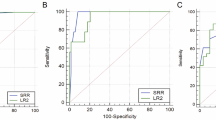Abstract
Background
The diagnostic performances of the International Ovarian Tumor Analysis (IOTA) ultrasound-based logistic regression model (LR2) and magnetic resonance imaging (MRI) in discriminating between benign and malignant adnexal masses have not been directly compared in a single study.
Methods
Using the IOTA LR2 model and subjective interpretation of MRI findings by experienced radiologists, 265 consecutive patients with adnexal masses were preoperatively evaluated in two hospitals between February 2014 and December 2015. Definitive histological diagnosis of excised tissues was used as a gold standard.
Results
From the 265 study subjects, 54 (20.4%) tumors were histologically diagnosed as malignant (including 11 borderline and 3 metastatic tumors). Preoperative diagnoses of malignant tumors showed 91.7% total agreement between IOTA LR2 and MRI, with a kappa value of 0.77 [95% confidence interval (CI), 0.68–0.86]. Sensitivity of IOTA LR2 (0.94, 95% CI, 0.85–0.98) for predicting malignant tumors was similar to that of MRI (0.96, 95% CI, 0.87–0.99; P = 0.99), whereas specificity of IOTA LR2 (0.98, 95% CI, 0.95–0.99) was significantly higher than that of MRI (0.91, 95% CI, 0.87–0.95; P = 0.002). Combined IOTA LR2 and MRI results gave the greatest sensitivity (1.00, 95% CI, 0.93–1.00) and had similar specificity (0.91, 95% CI, 0.86–0.94) to MRI.
Conclusions
The IOTA LR2 model had a similar sensitivity to MRI for discriminating between benign and malignant tumors and a higher specificity compared with MRI. Our findings suggest that the IOTA LR2 model, either alone or in conjunction with MRI, should be included in preoperative evaluation of adnexal masses.
Similar content being viewed by others
References
Kaijser J, Vandecaveye V, Deroose CM et al (2014) Imaging techniques for the pre-surgical diagnosis of adnexal tumours. Best Pract Res Clin Obstet Gynaecol 28:683–695
Timmerman D, Schwärzler P, Collins WP et al (1999) Subjective assessment of adnexal masses with the use of ultrasonography: an analysis of interobserver variability and experience. Ultrasound Obstet Gynecol 13:11–16
Kaijser J (2015) Towards an evidence-based approach for diagnosis and management of adnexal masses: findings of the International Ovarian Tumour Analysis (IOTA) studies. Facts Views Vis Obgyn 7:42–59
Meys EM, Kaijser J, Kruitwagen RF et al (2016) Subjective assessment versus ultrasound models to diagnose ovarian cancer: a systematic review and meta-analysis. Eur J Cancer 58:17–29
Sladkevicius P, Valentin L (2015) Interobserver agreement in describing the ultrasound appearance of adnexal masses and in calculating the risk of malignancy using logistic regression models. Clin Cancer Res 21:594–601
Zannoni L, Savelli L, Jokubkiene L et al (2014) Intra- and interobserver agreement with regard to describing adnexal masses using International Ovarian Tumor Analysis terminology: reproducibility study involving seven observers. Ultrasound Obstet Gynecol 44:100–108
Spencer JA, Forstner R, Cunha TM et al (2010) ESUR guidelines for MR imaging of the sonographically indeterminate adnexal mass: an algorithmic approach. Eur Radiol 20:25–35
Medeiros LR, Freitas LB, Rosa DD et al (2011) Accuracy of magnetic resonance imaging in ovarian tumor: a systematic quantitative review. Am J Obstet Gynecol 204:67 (e1–10)
Timmerman D, Testa AC, Bourne T et al (2005) Logistic regression model to distinguish between the benign and malignant adnexal mass before surgery: a multicenter study by the International Ovarian Tumor Analysis Group. J Clin Oncol 23:8794–8801
Tavassoli FA, Devilee P (eds) (2003) World Health Organization Classification of Tumors. Pathology and Genetics. Tumors of the breast and female genital organs. IARC Press, Lyon, pp 117–145
Valentin L, Ameye L, Savelli L et al (2011) Adnexal masses difficult to classify as benign or malignant using subjective assessment of gray-scale and Doppler ultrasound findings: logistic regression models do not help. Ultrasound Obstet Gynecol 38:456–465
Okamoto Y, Tanaka YO, Tsunoda H et al (2007) Malignant or borderline mucinous cystic neoplasms have a larger number of loculi than mucinous cystadenoma: a retrospective study with MR. J Magn Reson Imaging 26:94–99
Zhao SH, Qiang JW, Zhang GF et al (2014) MRI in differentiating ovarian borderline from benign mucinous cystadenoma: pathological correlation. J Magn Reson Imaging 39:162–166
Kaijser J, Van Gorp T, Van Hoorde K et al (2013) A comparison between an ultrasound based prediction model (LR2) and the risk of ovarian malignancy algorithm (ROMA) to assess the risk of malignancy in women with an adnexal mass. Gynecol Oncol 129:377–383
Acknowledgements
We thank Mr. Tetsutaro Hamano (P4 Statistics Co. Ltd., Tokyo, Japan) for statistical analysis. We are also grateful to all the women who participated in this study.
Author information
Authors and Affiliations
Corresponding author
Ethics declarations
Conflict of interest
All authors report no conflict of any financial interest.
About this article
Cite this article
Shimada, K., Matsumoto, K., Mimura, T. et al. Ultrasound-based logistic regression model LR2 versus magnetic resonance imaging for discriminating between benign and malignant adnexal masses: a prospective study. Int J Clin Oncol 23, 514–521 (2018). https://doi.org/10.1007/s10147-017-1222-y
Received:
Accepted:
Published:
Issue Date:
DOI: https://doi.org/10.1007/s10147-017-1222-y




